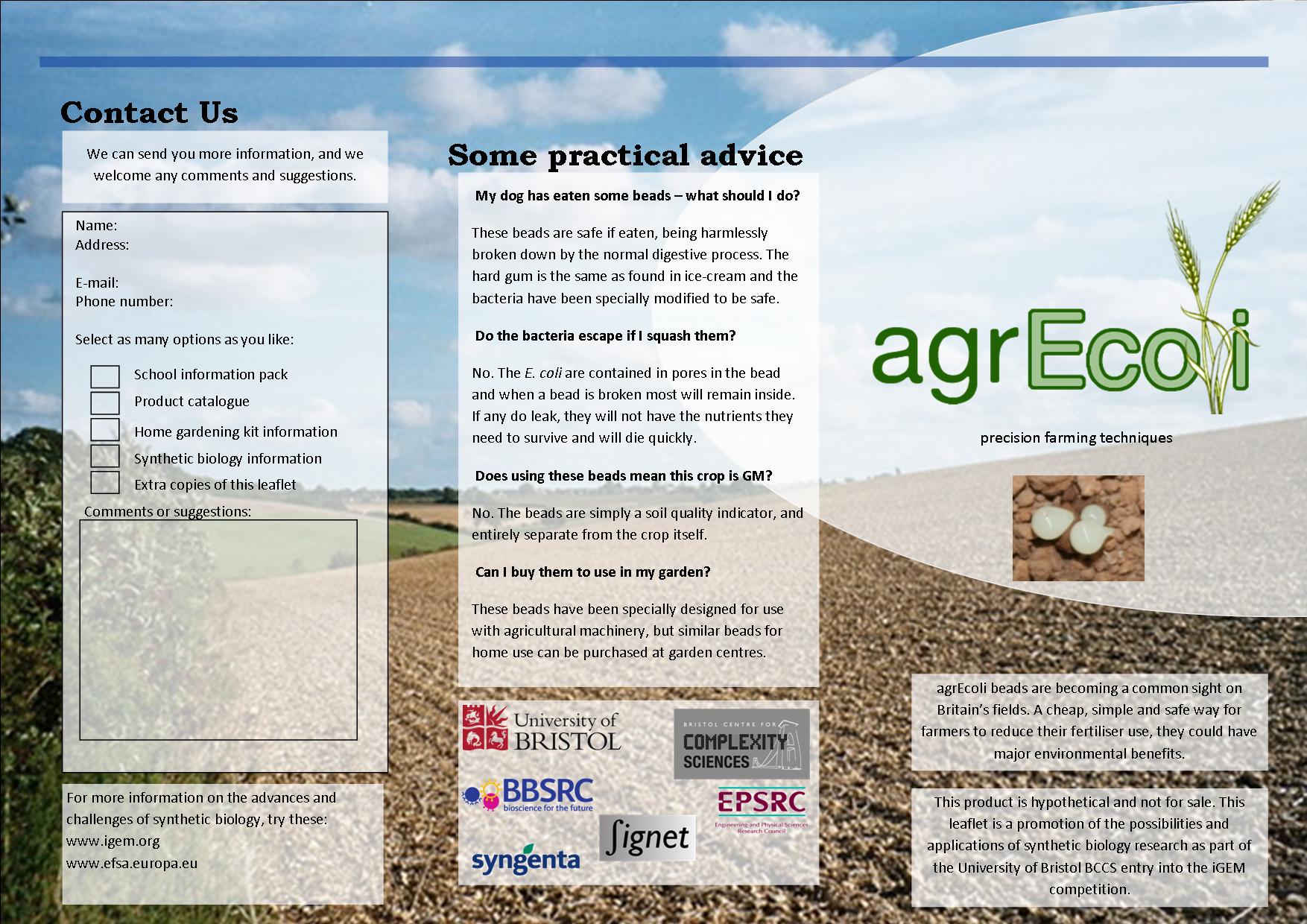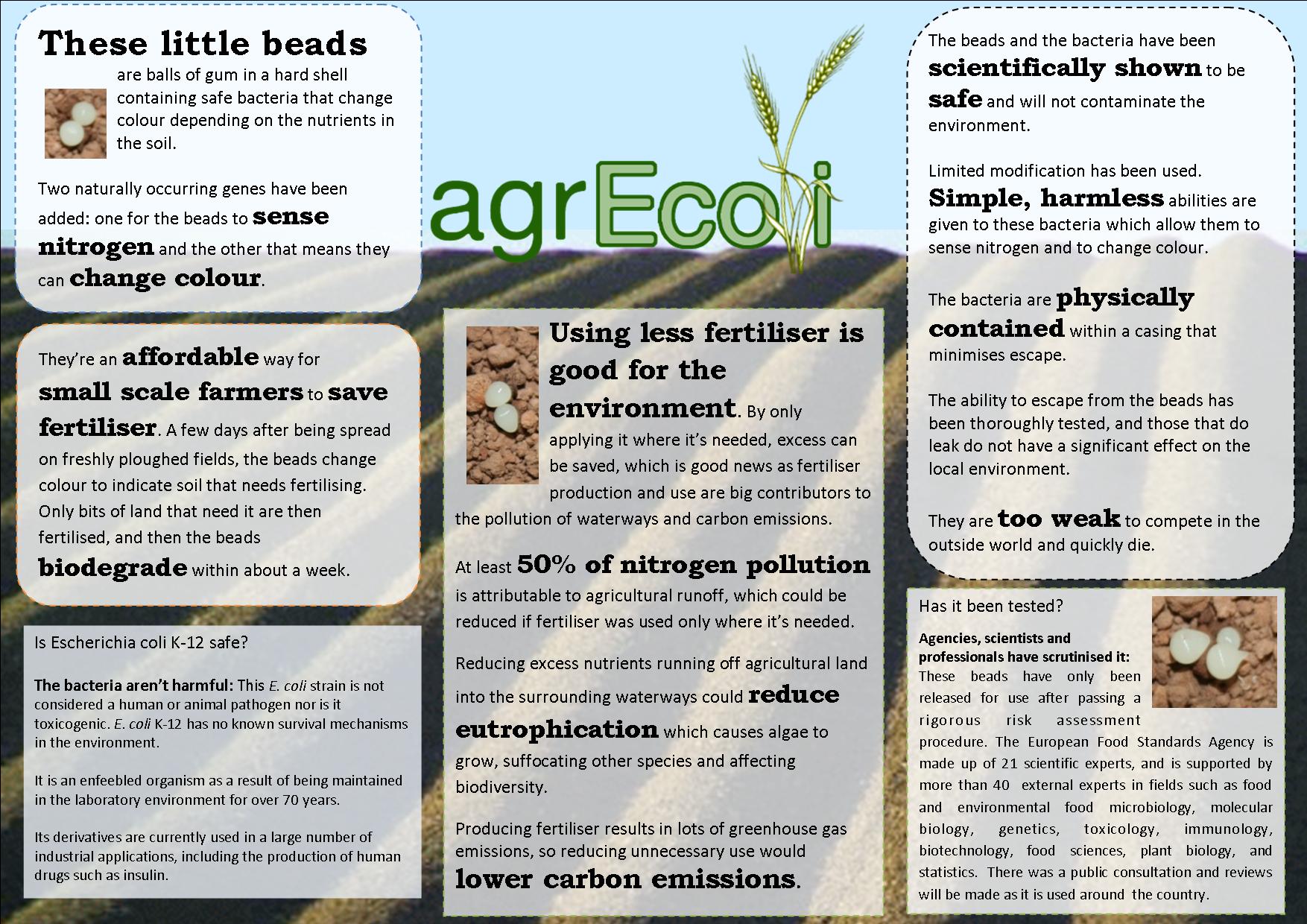Team:BCCS-Bristol/Human Practices/Marketing Campaign/Materials and Description
From 2010.igem.org
iGEM 2010
Product information leaflet
Contents |
There are several messages that we wish to include in the public information leaflet:
- explaining what the beads are and what they’re for;
- giving reassurance that they’re safe;
- explaining about E. coli;
- detailing the motivation for their development: environmental aims;
- providing useful and balanced sources for further reading.
These will address the most pressing issues identified from our investigation of survey conclusions.
We will consider each point in turn, which relates to a section of our leaflet. The text will be accompanied by our reasoning behind its inclusion and phrasing.
Below, you can see the final version of our leaflet. It is intended to be folded into three sections.
What are these beads?
These little beads are balls of gum in a hard shell that contain safe bacteria that change colour depending on the nutrients in the soil.
Two naturally occurring genes have been added: one for the beads to sense nitrogen and the other that means they can change colour.
The justification
We want to explicitly mention what the beads are made of, being upfront that they contain bacteria. This will be coupled with a separate description and reassurances about the safety of the E. coli strain used. We have addressed the fact that they are genetically modified without using emotive language, and have given details of the genetic manipulation in the context of allying fears of potential misuse, as they are simple harmless alterations affecting colour.
Informed by: our wet lab work
The beads are safe
The beads and the bacteria have been scientifically shown to be safe and will not contaminate the environment. Limited modification has been used. Simple, harmless abilities are given to these bacteria which allow them to sense nitrogen and to change colour. The bacteria are physically contained within a casing that minimises escape. The ability to escape from the beads has been thoroughly tested, and those that do leak do not have a significant effect on the local environment. They are too weak to compete in the outside world and quickly die.
The justification
By mentioning our novel delivery method - the bead structure - which has been proven in the lab, we intend to increase the separation between our modified E. coli and the ecosystem. Further development of the beads could include the development of an encapsulation method to provide a stronger barrier. The leakage can be modelled by BSim and they would have to have undergone thorough testing to gain approval for release. We have again mentioned that the bacteria are unable to survive well in the wild.
Informed by: our wet lab and modelling work.
What are they for?
They’re an affordable way for small scale farmers to save fertiliser. A few days after being spread on freshly ploughed fields, the beads change colour to indicate soil that needs fertilising. Only bits of land that need it are then fertilised, and then the beads biodegrade within about a week.
The justification
We have aimed our product at small scale farmers, and by emphasising the affordability of the scheme we intended to draw attention to our beads complementing local enterprise. They are not intended to favour large farming operations or prevent competition. By their nature they need to be purchased every year so this does not have to be explained explicitly.
Biodegrading products are promoted heavily as environmentally friendly life choices. We will need to ensure that the definition of ‘biodegrading’ is in fact the process that our beads undergo when they break down. This process is highlighted such that our beads are not seen as littering or contamination in any way: the bacteria are bead, the Gellan gum biodegrades.
Informed by: our wet lab work
What’s the motivation?
Using less fertiliser is good for the environment. By only applying it where it’s needed, excess can be saved, which is good news as fertiliser production and use are big contributors to the pollution of waterways and carbon emissions.
Reducing excess nutrients running off agricultural land into the surrounding waterways could reduce eutrophication which causes algae to grow, suffocating other species and affecting biodiversity.
At least 50% of nitrogen pollution is attributable to agricultural runoff, which could be reduced if fertiliser was used only where it’s needed.
Producing fertiliser is very inefficient so saving it could also mean lower carbon emissions.
The justification
The agricultural industry is accused in many reports to be a big contributor to eutrophication and carbon emissions. Without claiming that our beads will solve pollution problems entirely, it is justified to mention the positive effects of using less fertiliser, as this is already being promoted using other methods, such as GM crops that need less fertilizer and the SOYLsense technology.
Informed by: [http://www.ghgi.org.uk/sector.html], [http://www.official-documents.gov.uk/document/cm67/6764/6764.pdf], [http://www.eea.europa.eu/data-and-maps/indicators/exposure-of-ecosystems-to-acidification-2/exposure-of-ecosystems-to-acidification], [http://ec.europa.eu/environment/integration/research/newsalert/pdf/6na3.pdf], [http://www.soyl.co.uk/how-soylsense-works.aspx]
E. coli fact box
The bacteria aren’t harmful: This E. coli strain is not considered a human or animal pathogen nor is it toxicogenic. E. coli K-12 has no known survival mechanisms in the environment.
It is an enfeebled organism as a result of being maintained in the laboratory environment for over 70 years.
Its derivatives are currently used in a large number of industrial applications, including the production of human drugs such as insulin.
The justification
By explaining features of the strain of E.coli used, we can demonstrate that they should not upset local ecosystems or pose a threat.
We also need to provide up-front information to avoid association with the previous health scare of infections from petting zoos. A search of the BBC News website for “E.coli” on 11/9/2010 presents these four headlines top:
- “Health Protection Agency fined £25, 000 for E.coli spill”, 9 Jul 2010 82% relevance
- “Third case of E.coli bug at Cumbernauld nursery”, 4 Aug 2010 82% relevance
- “Two children at Cumbernauld nursery contract E.coli bug”, 3 Aug 2010 82% relevance
- “Death fear of Surrey petting farm E.coli outbreak boy”, 15 Jun 2010 82% relevance
Informed by: the United States Environment Protection Agency [http://www.epa.gov/oppt/biotech/pubs/fra/fra004.htm]
References
[1] [http://www.ghgi.org.uk/sector.html UK Greenhouse Gas Inventory National System, accessed September 2010]
[2] [http://www.official-documents.gov.uk/document/cm67/6764/6764.pdf Climate Change, The UK Programme 2006, accessed September 2009]
[3] [http://www.eea.europa.eu/data-and-maps/indicators/exposure-of-ecosystems-to-acidification-2/exposure-of-ecosystems-to-acidification European Environment Agency, accessed September 2010]
[4] [http://ec.europa.eu/environment/integration/research/newsalert/pdf/6na3.pdf EC Science for Environment Policy, accessed September 2010]
[5] [http://www.soyl.co.uk/how-soylsense-works.aspx SOYL sense, accessed September 2010]
[6] [http://www.epa.gov/oppt/biotech/pubs/fra/fra004.htm the United States Environment Protection Agency, accessed October 2010]
 "
"

